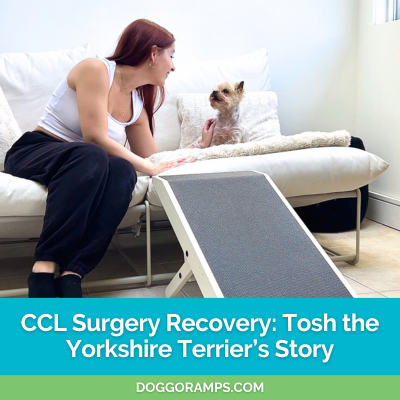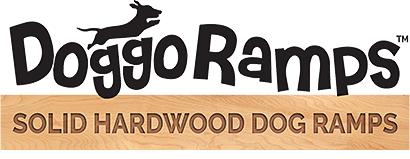CCL Surgery Recovery: Tosh the Yorkshire Terrier's Story

Meet Tosh - a feisty 10-year-old Yorkie with a passion for fetch, long walks (as long as it’s not raining), and chasing squirrels out of his yard.
Unfortunately, like many Yorkshire Terriers, Tosh has been susceptible to joint issues, especially in his hind legs.
In October 2024, he tore his Cranial Cruciate Ligament (CCL) in his back left leg.
Within 4 weeks, he underwent a CCL repair surgery, and after months of rest, rehabilitation, and care, he has made a remarkable recovery.
Today, our very own team member, Ania, is sharing her pup’s CCL surgery and recovery journey.
By sharing Tosh’s story, we hope to raise awareness about CCL tears in small dogs and how dog ramps will continue to help protect Tosh’s joints - so he can enjoy his favorite activities during his senior years.
Cranial Cruciate Ligament (CCL) Tears in Dogs
A cranial cruciate ligament tear is one of the most common knee injuries in dogs. The ligament is one of two that helps stabilize and ensure the proper functioning of a dog’s knee. It is comparable to a human’s anterior cruciate ligament (ACL).

However, unlike humans, a single traumatic injury is seldom responsible for a CCL rupture in dogs. Instead, it more commonly deteriorates over time due to a variety of factors. These factors can include aging, genetics, weight, and other abnormalities in surrounding joints or bones, such as an untreated luxating patella.
Once weakened, the ligament can more easily tear during a higher-impact activity, such as running or jumping.
A dog with a ruptured CCL may experience lameness in the affected leg as well as pain. The instability caused by the torn ligament can further damage surrounding bones and even cause osteoarthritis. Surgery is often needed to stabilize the knee joint.
Tosh the Yorkie’s CCL Tear
Despite being a very small dog, Tosh has always been a bold, energetic, and active pup.
His pawrents always made sure he got regular exercise appropriate for his size and made an effort to avoid excessive high-impact activities, such as jumping off higher surfaces.
So his CCL tear came as a surprise.
Near the end of October last year, Tosh’s owners took him for one of his usual early evening walks. One moment, he was walking on all fours. The next, he simply stopped and didn’t want to budge. There was no accident or mishap.
A few moments later, he tried to take a couple of steps but refused to put any weight on his back left leg.

The following day during an appointment, Tosh’s vet confirmed that the pup had experienced a full CCL tear.
Since there had been no specific event or incident that triggered the tear, the vet suspected that age and genetics had likely played a role in the weakening of his ligament, leading to its eventual rupture.
His owners were informed that Tosh would only be able to regain proper use of his leg through surgery.
Just shy of 10 at the time, Tosh’s pawrents wanted nothing more than for him to be able to enjoy his favorite activities again, so they asked to be referred for a surgery consultation.

After 3 weeks, Tosh had his surgery consultation where he was booked for a CCL Extracapsular Repair the following week on November 21, 2024.
CCL Surgery in Dogs: TPLO vs. Extracapsular Repair
There are generally two types of procedures that are commonly used to repair a dog’s CCL:
- Tibial Plateau Leveling Osteotomy (TPLO)
- Extracapsular Repair (or Lateral Suture Technique)
A TPLO surgery is more invasive as it involves reshaping a dog’s tibial plateau. It tends to be the most successful surgical option for large dogs, especially if they are active.
On the other hand, an Extracapsular Repair involves using sterile suture material to act as an "artificial” ligament that helps stabilize a dog’s knee joint. During recovery, scar tissue will develop in the area and help to further stabilize the joint. Extracapsular repairs are more commonly recommended and have a fairly high success rate for small dogs.
In addition to the TPLO, another biomechanical surgery called TTA (Tibial Tuberosity Advancement) has also started becoming more common since 2004.
Tosh the Yorkie’s CCL Surgery
Weighing only 7lbs and on the cusp of entering his senior years, Tosh’s surgeon recommended he undergo an Extracapsular Repair instead of a TPLO. As a less invasive procedure, it would be easier on Tosh. Due to his very small size, the surgery was projected to have a very high success rate.
Tosh’s owners agreed to proceed with the surgery and left Tosh in their local animal hospital’s care on the morning of November 21st. They were nervous and worried, but fortunately, by noon, they received a call that the surgery had gone smoothly without any complications. Tosh would have to be monitored overnight, but he was scheduled for pick-up the following morning.
Prior to pick-up, his owners received a booklet full of recovery instructions covering his medication schedule to prevent infection and reduce pain, an overview of what his 12-week period of activity restriction would entail, and a schedule with his follow up appointments. They carefully reviewed all the information and were relieved to be able to bring their pup back home.

CCL Surgery Recovery
Even though the surgery was over, Tosh still had 3 months of recovery ahead of him.
Since the success of an extracapsular repair relies on the suture maintaining its tension and integrity as scar tissue forms, Tosh’s recovery involved a 12-week period of restricted activity with controlled stretches and rehabilitation exercises starting 4 weeks post-op.
Other than quick, leashed bathroom breaks outdoors, Tosh spent the first month following his surgery under strict crate rest. During his one month check-up, he was cleared to start spending short periods of time outside of his crate under supervision - to make sure he didn’t accidentally overexert his recovering leg.

As an energetic pup, spending so much time resting didn’t come easily to Tosh, but with the help of his favorite snuffle mat and lots of attention from his owners, he followed his recovery plan to a tee.

By mid-February, he was back to comfortably and regularly using his back left leg and enjoying his favorite activity - outdoor walks.
CCL Recovery: Long-Term Accommodations
In Tosh’s case, experiencing a CCL tear has called for lifelong changes in his home environment.
Since his tear was the result of his ligament degenerating over time, Tosh’s specialist gave him a 70% chance of experiencing the same issue in his back right leg. When one CCL tears, it’s common for the other to be already weakened and potentially tear as well.
In order to reduce the chances of this happening, Tosh humans have introduced several accommodations into their home in order to significantly reduce the amount of stress he puts on his joints on a daily basis.
While any CCL repair surgery is expensive and can cost in the thousands, both the surgery and recovery process also demand a great deal of resilience, courage, and patience from our four-legged friends.
Tosh’s owners want to do what they can to help prevent their pup from going through such a long and challenging experience again.

Preventing Accidental Slips
Carpets, yoga mats, and grippy gym floor tiles now cover Tosh’s favorite routes throughout his home to prevent any accidental slipping. Even though Tosh rarely chose to use stairs on his own before, they now remain completely blocked off if he were to change his mind.
Preventing Jumping On and Off Furniture with Dog Ramps
Like many small dogs, Tosh loves spending time on furniture, and his dog ramps allow him to safely and independently continue enjoying his favorite spots with ease.
He loves his DoggoRamps Couch Ramp and Small Bed Ramp as both ramps offer a gradual incline that’s easy on his knees, and the anti-slip pawgrip provides him with exceptional grip on his way up and down each ramp. Excellent traction on a ramp is a MUST as slipping can cause him to accelerate wear and tear on his right CCL.

Safety rails stop him from jumping off the ramp partway, and since he’s distrustful of anything with a wobble, the solid hardwood build of both ramps gives him the sturdiness he needs to reliably use a ramp. Tosh’s owners cannot imagine a home without DoggoRamps!

While Tosh is well-trained, his owners didn't want to take the chance that he might consider jumping off the couch due to an unexpected sound, such as a sudden knock on the door. To accompany his ramp, they made an acrylic barrier to block off any available jumping paths.
Even though Tosh’s CCL surgery recovery was long and had its challenges, his pawrents couldn’t be happier to see him walking on all four legs again and enjoying time outdoors. They continue to be committed to providing him with the best care and experiences possible, especially as he enters his senior years.

Inspired by Tosh's journey and looking to support your own furry friend's joints and independence?
Learn more about finding the right indoor ramp for your dog and setup here:
- The DoggoRamps Couch Ramp (supports dogs up to 150 lbs.)
- The DoggoRamps Small Bed Ramp (supports dogs up to 50 lbs.)
- The DoggoRamps Large Bed Ramp (supports dogs up to 200 lbs.)
- The DoggoRamps Step-Ramp (supports dogs up to 200 lbs.)
- The DoggoTeam
Leave a comment
Comments will be approved before showing up.




